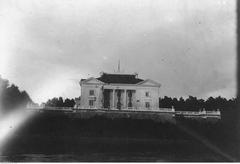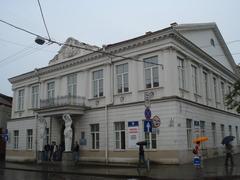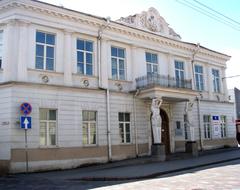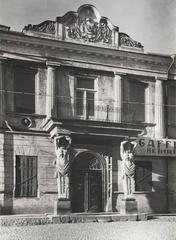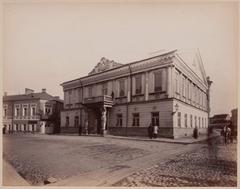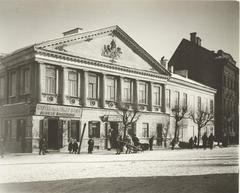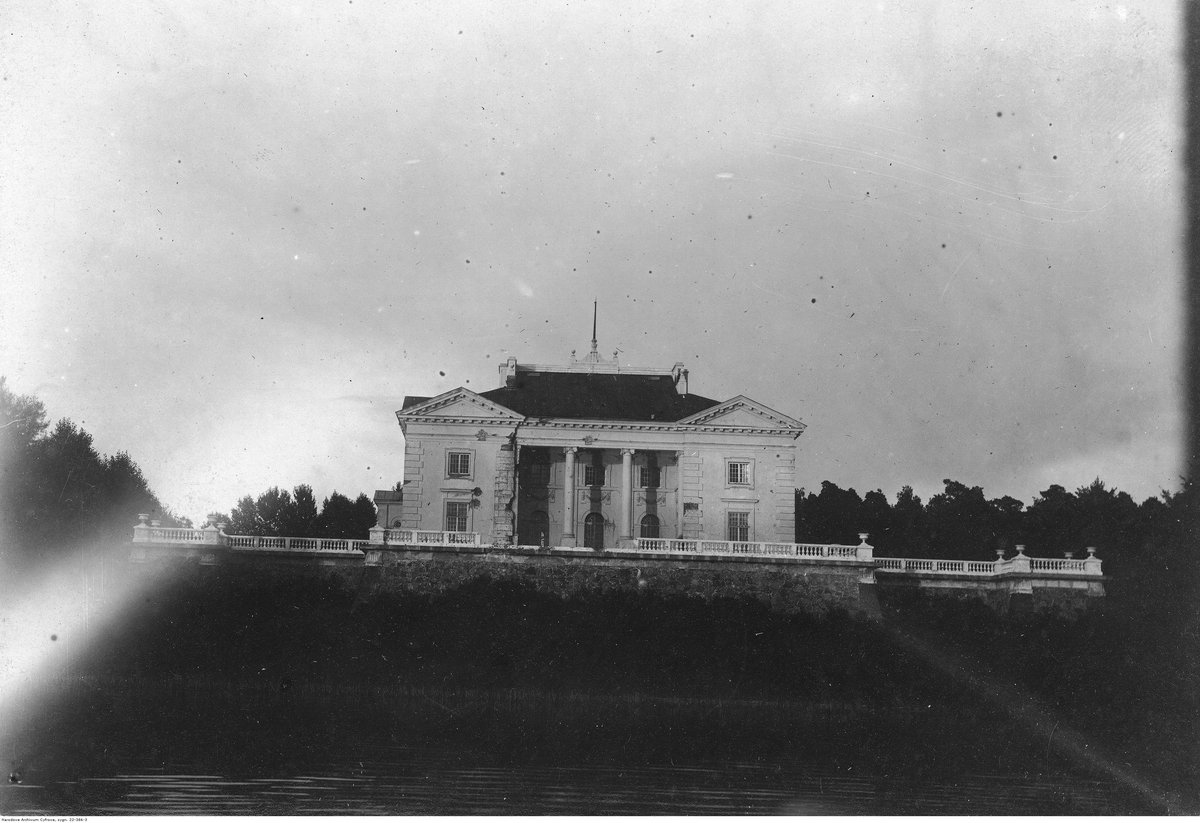
Tiškevičiai Palace Vilnius: Visiting Hours, Tickets, and Historical Sites Guide
Date: 14/06/2025
Introduction
Tiškevičiai Palace stands as a distinguished symbol of Lithuania’s aristocratic heritage and architectural evolution. Located in the heart of Vilnius, this Neoclassical monument, commissioned by the illustrious Tiškevičius family, offers visitors an immersive journey through the nation’s political, social, and cultural history from the late 18th century onward. Its stately façade and iconic Atlases statues reflect the European influences that shaped Lithuanian architecture during the Enlightenment era (True Lithuania). Situated on Trakų Street in Vilnius Old Town, the palace is surrounded by prominent landmarks like Vilnius Cathedral and the Presidential Palace, making it a focal point for any exploration of the city’s historical core (Kurby Blog).
Beyond Vilnius, the Tiškevičiai family’s legacy endures in Palanga, where their seaside palace now houses the Amber Museum, preserving Baltic amber artifacts within the scenic Palanga Botanical Park (Trek Zone). Both palaces continue to play vibrant roles in Lithuania’s cultural life, hosting exhibitions, guided tours, and public events.
This comprehensive guide provides essential details for planning your visit to Tiškevičiai Palace in Vilnius and Palanga, including visiting hours, ticketing, accessibility, special events, and travel tips. Whether you are a history enthusiast, architecture aficionado, or cultural traveler, Tiškevičiai Palace is an unmissable Lithuanian landmark.
Contents
- Introduction
- Historical Background and Architectural Significance
- Origins and Construction
- The Tiškevičius Family and Their Legacy
- Historical Transformations
- Architectural Features
- Neoclassical and Empire Style Elements
- Urban Context and Decorative Highlights
- Visiting Tiškevičiai Palace: Practical Information
- Visiting Hours
- Tickets and Admission
- Accessibility
- Guided Tours and Events
- Nearby Attractions and Travel Tips
- Tiškevičiai Palace in Palanga: Amber Museum and Botanical Park
- Museum Highlights
- Visiting Hours and Tickets
- Accessibility and Visitor Facilities
- Events and Educational Programs
- FAQs
- Plan Your Visit and Stay Connected
- Sources
Historical Background and Architectural Significance
Origins and Construction
Tiškevičiai Palace in Vilnius, often referred to as the Tiškevičius Palace, was built in the late 18th and early 19th centuries, marking the ascendance of Neoclassical architecture in Lithuania. The Tiškevičius family, among the most influential noble houses in the Grand Duchy of Lithuania, commissioned this grand residence as a statement of their power and taste, drawing inspiration from the classical traditions of Rome and the prevailing European styles of the era (True Lithuania).
The Tiškevičius Family and Their Legacy
Beyond Vilnius, the family’s legacy is evident in other estates, particularly in Palanga, where their palace-turned-museum preserves both their personal history and the wider cultural context of Lithuania. The Tiškevičiai not only shaped the built environment but also played significant roles as patrons of the arts and in national politics (Turizmogidas).
Historical Transformations
Throughout the 19th and 20th centuries, Vilnius underwent considerable changes under Russian Imperial and later Soviet rule. The palace, like many aristocratic residences, adapted to shifting political realities, serving various functions while preserving its architectural integrity (Cambridge Scholars). Restoration efforts since Lithuania’s independence have revitalized the palace, ensuring its continued role as a cultural and historical monument.
Architectural Features
Neoclassical and Empire Style Elements
The palace’s façade is a quintessential example of Neoclassical restraint, marked by symmetry, classical columns, and minimal ornamentation. The imposing Atlases statues supporting the portico are distinctive features, signaling a transition to the more ornate Empire style that gained popularity in the early 19th century (True Lithuania).
Urban Context and Decorative Highlights
Nestled among the diverse architectural styles of Vilnius Old Town, the palace is part of a dynamic urban ensemble that includes Gothic, Renaissance, and Baroque edifices (Kurby Blog). The interior, where accessible, features period stuccowork and decorative schemes that evoke the opulence of Lithuania’s noble past, though some original elements have been lost or restored.
Visiting Tiškevičiai Palace: Practical Information
Visiting Hours
- Vilnius: Open Tuesday–Sunday, 10:00 AM–6:00 PM. Closed Mondays and select public holidays. Check the official website for seasonal or event-related changes.
- Palanga (Amber Museum): Open daily 10:00 AM–6:00 PM (extended summer hours; check official site for updates).
Tickets and Admission
- Vilnius: Standard admission €8–€10; reduced rates (~€5) for students, seniors, and children. Family and group tickets are available. Advance purchase recommended during peak periods.
- Palanga: Affordable entry; discounts for students, seniors, and certain cardholders. Tickets available onsite and online (Official Palanga Amber Museum website).
Accessibility
- Vilnius: Main floors are wheelchair accessible via ramps and elevators; some historic areas may have limited access. Contact the palace for assistance or special accommodations.
- Palanga: Wheelchair access to main exhibition areas and paved garden paths; accessible restrooms; special tours for visitors with visual or hearing impairments.
Guided Tours and Events
Guided tours in Lithuanian, English, and Russian are available in both palaces, offering insights into architecture, history, and the family’s legacy. Advance booking is advised for groups. Both sites host year-round exhibitions, concerts, workshops, and seasonal festivals. Consult event calendars for details.
Nearby Attractions and Travel Tips
- Vilnius: Combine your visit with nearby landmarks such as Vilnius Cathedral, the Presidential Palace, Gediminas Tower, and the bohemian Užupis district (The Crazy Tourist).
- Photography: Allowed in most areas; flash and tripods may be restricted. Always check with staff.
- Dining and Souvenirs: Onsite or nearby cafés and gift shops offer refreshments and Lithuanian crafts.
Tiškevičiai Palace in Palanga: Amber Museum and Botanical Park
Museum Highlights
Set in a restored 19th-century palace, the Amber Museum houses over 28,000 amber specimens, including rare pieces with prehistoric inclusions. Rotating exhibitions, hands-on workshops (such as amber polishing), and family-friendly programs make it a dynamic cultural destination (Trek Zone).
Palanga Botanical Park
Surrounding the palace, the park was designed by French landscape architect Édouard André and features more than 500 tree and shrub species, ponds, and flowerbeds—perfect for a scenic stroll or photography (Trek Zone).
Events and Educational Programs
The palace and park host the annual Amber Festival, open-air concerts, and Museum Night events. Guided tours and educational workshops cater to all ages and interests (Palanga Tourist Information).
Frequently Asked Questions (FAQ)
Q: Where is Tiškevičiai Palace?
A: Trakų Street 2, Vilnius Old Town, and 17 Vytauto g., Palanga.
Q: What are the visiting hours?
A: Vilnius: Tue–Sun, 10:00–18:00; Palanga: Daily 10:00–18:00 (check for updates).
Q: How much are tickets?
A: Vilnius: €8–€10 standard; discounts available. Palanga: Affordable, with reduced rates for eligible visitors.
Q: Are guided tours available?
A: Yes, in multiple languages; advance booking recommended for groups.
Q: Is the palace accessible?
A: Main areas in both palaces are accessible; check for limitations in historic sections.
Q: Can I take photos?
A: Non-flash photography is allowed in most areas; restrictions may apply.
Q: What else should I see nearby?
A: In Vilnius: Cathedral, Gediminas Tower, Užupis, local markets, and museums.
Plan Your Visit and Stay Connected
Maximize your experience by planning ahead:
- Purchase tickets online to avoid queues.
- Download the Audiala mobile app for audio guides and walking tours.
- Follow official websites and social media for the latest updates on hours, events, and exhibitions.
- Respect palace rules regarding photography and conduct.
Sources
- True Lithuania, 2025, Neoclassical architecture in Lithuania
- Turizmogidas, 2025, The Palace of Count Feliksas Tiškevičius (now Amber Museum)
- Cambridge Scholars, 2025, Sample PDF on Lithuanian Architecture and History
- Kurby Blog, 2025, From Past to Present: The Evolution of Vilnius, Lithuania’s Architecture
- Trek Zone, 2025, Tiškevičiai Palace Palanga
- Vilnius Tourism, 2025, Visit Vilnius Official Site
- The Crazy Tourist, 2025, 25 Best Things to Do in Lithuania
- Wikipedia, 2025, Tiškevičiai Palace (Vilnius)
- Gateway Travel, 2025, Exploring Vilnius: Ultimate Travel Guide 2025
- My Global Viewpoint, 2025, Best Things to Do in Vilnius, Lithuania
- Nomadic Matt, 2025, Lithuania Travel Guide
- National Museum of Lithuania, 2025, Official Museum Website
- Palanga Tourist Information, 2025, Official Site
- Official Palanga Amber Museum Website, 2025
